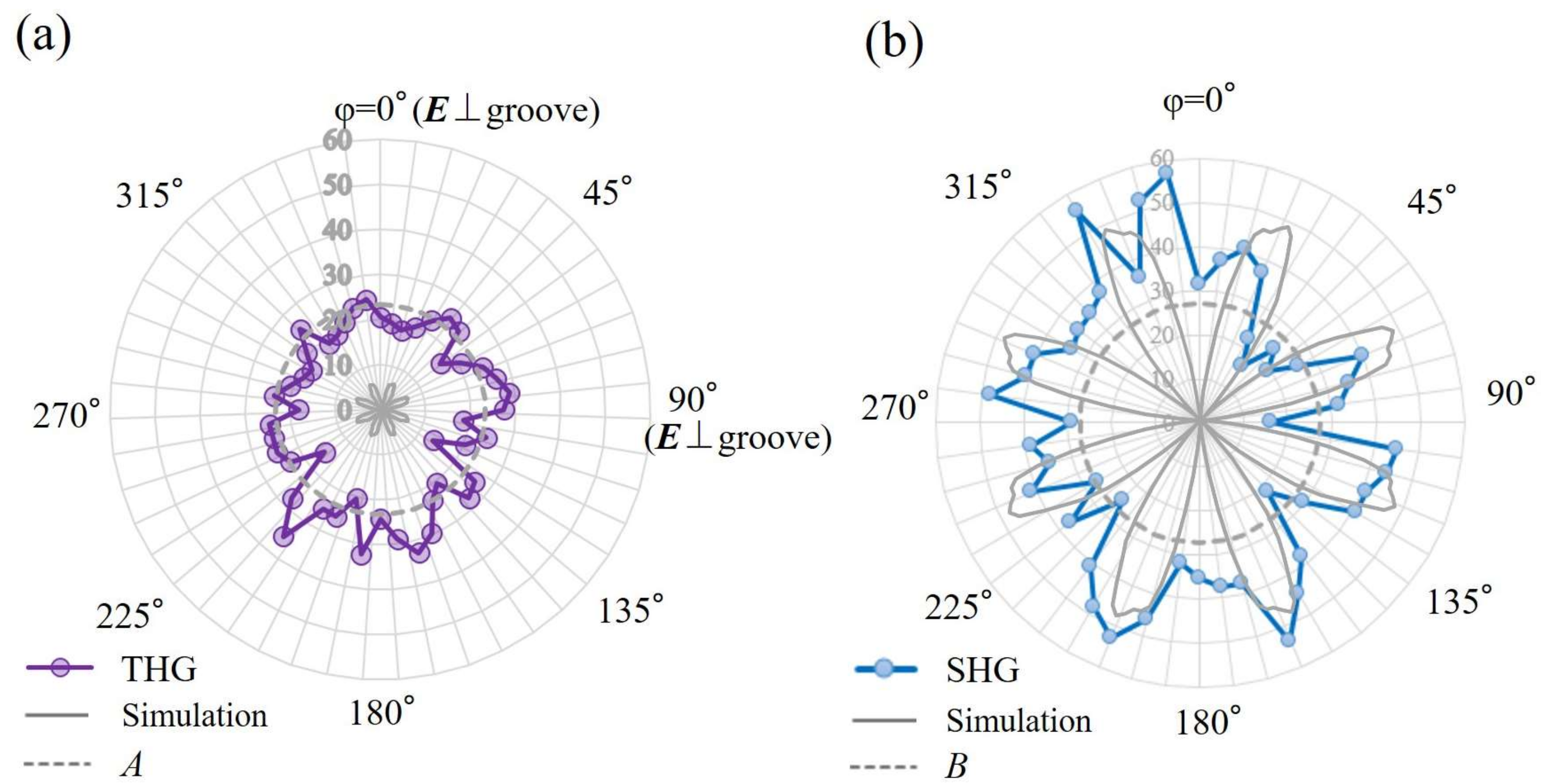Optical Third Harmonic Generation Using Nickel Nanostructure-Covered Microcube Structures
Abstract
:1. Introduction
2. Materials and Methods
3. Results
3.1. Definition of THG Intensity for Ni NC-MCs
3.2. THG Signal Intensity for Ni NC-MCs
4. Conclusions
Acknowledgments
Author Contributions
Conflicts of Interest
References
- Boyd, R.W. Nonlinear Optics, 3rd ed.; Academic Elsevier: Amsterdam, The Netherlands, 2008. [Google Scholar]
- Shen, Y.R. The Principles of Nonlinear Optics; John Wiley & Sons: New York, NY, USA, 1984. [Google Scholar]
- Kauranen, M.; Zayats, A.V. Nonlinear plasmonics. Nat. Photonics 2012, 6, 737–748. [Google Scholar] [CrossRef]
- Ogata, Y.; Mizutani, G. Control of Cross-Sections and Optical Nonlinearity of Pt Nanowires and the Roughness Effect. Phys. Res. Int. 2012, 2012, 969835. [Google Scholar] [CrossRef]
- Monat, C.; Grillet, C.; Collins, M.; Clark, A.; Schroeder, J.; Xiong, C.; Li, J.; O’faolain, L.; Krauss, T.F.; Eggleton, B.J.; et al. Integrated optical auto-correlator based on third-harmonic generation in a silicon photonic crystal waveguide. Nat. Commun. 2014, 5, 3246. [Google Scholar] [CrossRef] [PubMed] [Green Version]
- Olivier, N.; Aptel, F.; Plamann, K.; Schanne-Klein, M.C.; Beaurepaire, E. Harmonic microscopy of isotropic and anisotropic microstructure of the human cornea. Opt. Express 2010, 18, 5028–5040. [Google Scholar] [CrossRef] [PubMed]
- Tsang, T.Y. Surface-plasmon-enhanced third-harmonic generation in thin silver films. Opt. Lett. 1996, 21, 245–247. [Google Scholar] [CrossRef] [PubMed]
- Niu, J.; Luo, M.; Liu, Q.H. Enhancement of graphene’s third-harmonic generation with localized surface plasmon resonance under optical/electro-optic Kerr effects. JOSA B 2016, 33, 615–621. [Google Scholar] [CrossRef]
- Nezami, M.S.; Gordon, R. Localized and propagating surface plasmon resonances in aperture-based third harmonic generation. Opt. Express 2015, 23, 32006–32014. [Google Scholar] [CrossRef] [PubMed]
- Piccione, B.; Aspetti, C.O.; Cho, C.H.; Agarwal, R. Tailoring light–matter coupling in semiconductor and hybrid-plasmonic nanowires. Rep. Prog. Phys. 2014, 77, 086401. [Google Scholar] [CrossRef] [PubMed]
- Vorobyev, A.Y.; Guo, C. Effects of nanostructure-covered femtosecond laser-induced periodic surface structures on optical absorptance of metals. Appl. Phys. A 2007, 86, 321–324. [Google Scholar] [CrossRef]
- Hwang, T.Y.; Vorobyev, A.Y.; Guo, C. Surface-plasmon-enhanced photoelectron emission from nanostructure-covered periodic grooves on metals. Phys. Rev. B 2009, 79, 085425. [Google Scholar] [CrossRef]
- Ogata, Y.; Vorobyev, A.; Guo, C. Symmetry-sensitive plasmonic enhancement of nonlinear optical intensity in nano-micro hierarchical structures on silver. Surf. Interface Anal. 2016, 48, 1108–1113. [Google Scholar] [CrossRef]
- Ogata, Y. Optical second harmonic generation from nanostructure-covered micro-cubes on nickel. Opt. Mater. Express 2016, 6, 1520–1529. [Google Scholar] [CrossRef]
- Ogata, Y.; Guo, C. Nonlinear optics on nano/microhierarchical structures on metals: Focus on symmetric and plasmonic effects. Nano Rev. Exp. 2017, 8, 1339545. [Google Scholar] [CrossRef]
- Gangadharan, D.T.; Xu, Z.; Liu, Y.; Izquierdo, R.; Ma, D. Recent advancements in plasmon-enhanced promising third-generation solar cells. Nanophotonics 2016, 6, 153–175. [Google Scholar]
- Chen, S.; Li, G.; Zeuner, F.; Wong, W.H.; Pun, E.Y.B.; Zentgraf, T.; Cheah, K.W.; Zhang, S. Symmetry-selective third-harmonic generation from plasmonic metacrystals. Phys. Rev. Lett. 2014, 113, 033901. [Google Scholar] [CrossRef] [PubMed]
- Ashok, A.; Arackal, A.; Jacob, G. Study of Surface Plasmon Excitation on Different Structures of Gold and Silver. Nanosci. Nanotechnol. 2015, 5, 71–81. [Google Scholar]
- Kontio, J.M.; Husu, H.; Simonen, J.; Huttunen, M.J.; Tommila, J.; Pessa, M.; Kauranen, M. Nanoimprint fabrication of gold nanocones with ~10 nm tips for enhanced optical interactions. Opt. Lett. 2009, 34, 1979–1981. [Google Scholar] [CrossRef] [PubMed]
- Gomopoulos, N.; Lütgebaucks, C.; Sun, Q.; Macias-Romero, C.; Roke, S. Labal-free second harmonic and hyper Rayleigh scattering with high efficiency. Opt. Express 2013, 21, 815–821. [Google Scholar] [CrossRef] [PubMed]
- Hubert, C.; Billot, L.; Adam, P.M.; Bachelot, R.; Royer, P.; Grand, J.; Gindre, D.; Dorkenoo, K.D.; Fort, A. Role of surface plasmon in second harmonic generation from gold nanorods. Appl. Phys. Lett. 2007, 90, 181105. [Google Scholar] [CrossRef]
- Toroghi, S.; Kik, P.G. Cascaded plasmon resonant field enhancement in nanoparticle dimers in the point dipole limit. Appl. Phys. Lett. 2012, 100, 183105. [Google Scholar] [CrossRef]



© 2018 by the authors. Licensee MDPI, Basel, Switzerland. This article is an open access article distributed under the terms and conditions of the Creative Commons Attribution (CC BY) license (http://creativecommons.org/licenses/by/4.0/).
Share and Cite
Ogata, Y.; Vorobyev, A.; Guo, C. Optical Third Harmonic Generation Using Nickel Nanostructure-Covered Microcube Structures. Materials 2018, 11, 501. https://doi.org/10.3390/ma11040501
Ogata Y, Vorobyev A, Guo C. Optical Third Harmonic Generation Using Nickel Nanostructure-Covered Microcube Structures. Materials. 2018; 11(4):501. https://doi.org/10.3390/ma11040501
Chicago/Turabian StyleOgata, Yoichi, Anatoliy Vorobyev, and Chunlei Guo. 2018. "Optical Third Harmonic Generation Using Nickel Nanostructure-Covered Microcube Structures" Materials 11, no. 4: 501. https://doi.org/10.3390/ma11040501



